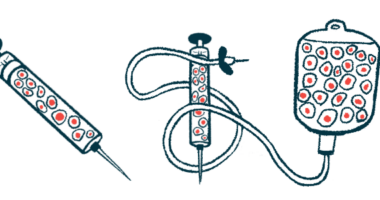Gene-edited cell therapy for severe SCD lands new FDA designation
BEAM-101 awarded regenerative medicine advanced therapy status, perks

The U.S. Food and Drug Administration (FDA) has granted regenerative medicine advanced therapy (RMAT) designation to Beam Therapeutic’s BEAM-101, a one-time, gene-edited cell therapy for severe sickle cell disease (SCD).
RMAT status is granted to therapies that have shown potential for treating serious or life-threatening conditions. It provides a series of benefits, including early talks with the FDA about trial design, and the possibility of priority review for a future biologics license application (BLA) seeking a therapy’s approval.
BEAM-101 already was granted the FDA’s orphan drug designation, which also provides several advantages — among them, market exclusivity for a period of seven years should the treatment ultimately be approved. Orphan drug status, awarded to treatments for rare diseases, also comes with economic incentives and assistance with the regulatory approval process.
“We are thrilled that the FDA has granted RMAT designation to BEAM-101, following orphan drug designation earlier this year, reinforcing its potential as a one-time, best-in-class therapy for severe sickle cell disease,” Giuseppe Ciaramella, PhD, Beam’s president, said in a company press release. “These designations not only recognize the promise of BEAM-101 but also enable enhanced collaboration with the FDA as we advance toward a BLA filing.”
SCD is caused by mutations that lead to the production of an abnormal form of adult hemoglobin, the protein responsible for transporting oxygen in red blood cells. This defective version, known as sickle hemoglobin, or HbS, causes red blood cells to take on a rigid, crescent-like shape. The misshaped cells are more likely to clump together and obstruct small blood vessels, which can trigger episodes of acute pain known as vaso-occlusive crises (VOCs), along with other complications.
BEACON clinical trial now testing gene-edited therapy in SCD patients
BEAM-101 is designed to counteract the effects of HbS by reactivating the production of fetal hemoglobin (HbF), an alternative form of the protein that is naturally produced during fetal development. HbF usually is replaced by adult hemoglobin shortly after birth.
The experimental therapy uses a precise gene-editing method that alters individual DNA bases without cutting the DNA strand. The process begins with the collection of a patient’s hematopoietic stem cells, which are responsible for giving rise to all types of blood cells. These cells are then modified in the lab to enhance the production of HbF.
Following conditioning chemotherapy with busulfan to eliminate the person’s existing stem cells, the edited cells are reinfused into the patient. The modified stem cells are then expected to give rise to new red blood cells that are rich in HbF.
A Phase 1/2 clinical trial called BEACON (NCT05456880) is assessing how safe and effective BEAM-101 is in treating people with severe SCD. It enrolled patients ages 18-35 who had experienced at least four VOCs in the two years before joining the trial.
The most recent data from trial, which began dosing last year, support the therapy’s long-term efficacy, with durable therapeutic benefits sustained for more than one year after treatment.
Use of BEAM-101 led to reactivation of fetal hemoglobin in over half
Data from 17 of 30 dosed patients showed that BEAM-101 led to a robust and sustained reactivation of HbF, with levels exceeding 60% of their total hemoglobin. The proportion of HbS was sustainably reduced, to below 40%.
Total hemoglobin levels also increased rapidly, and anemia — a condition that occurs when there aren’t enough red blood cells or hemoglobin to carry oxygen efficiently through the body — was resolved. These effects were sustained for up to 15.1 months.
Additionally, there was a quick recovery of neutrophil and platelet counts following the transplant. This indicates the modified stem cells had successfully engrafted, or taken in, and started producing healthy blood cells, according to the company. Neutrophils are a type of white blood cell that play a crucial role in the immune response by helping the body fight off infections. Platelets, meanwhile, are essential for blood clotting and preventing excessive bleeding.
No VOCs were reported following engraftment.
With 30 patients now dosed in the BEACON Phase 1/2 trial and additional data expected later this year, we remain focused on delivering a transformative treatment to people living with sickle cell disease.
The therapy’s safety profile was consistent with what is typically observed in stem cell transplants conducted following busulfan administration. Common side effects included inflammation of the mucous membranes in the mouth, known as stomatitis, fever related to reduced white blood cell counts, called febrile neutropenia, and temporary anemia. There were no safety concerns associated with the gene therapy itself.
Beam plans to present updated data from BEACON before the end of the year, per the release.
“With 30 patients now dosed in the BEACON Phase 1/2 trial and additional data expected later this year, we remain focused on delivering a transformative treatment to people living with sickle cell disease,” Ciaramella said.








